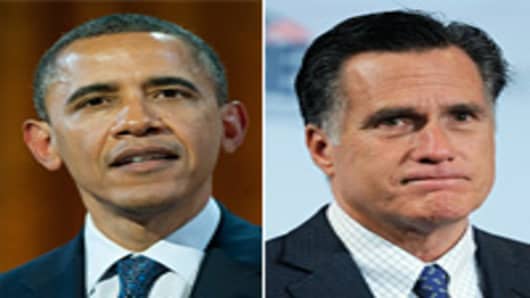There hasn't been all that much talk this election year about U.S. energy policies and the environment. But there are some major differences between the two presidential candidates.
So here are the stated positions of President Barack Obama and Mitt Romney on the environment and energy policies.
Obama: Obama's first term saw the adoption of toxic and carbon pollution reduction measures. The government also updated fuel-economy standards for the first time in two decades, and invested funds in energy efficiency and renewable electricity.
Stating his belief that global warming is "not a hoax," Obama got the first-ever government regulations on heat-trapping gases blamed for global warming and on toxic mercury pollution from power plants.
In his first term Obama ordered a temporary moratorium on deep-water drilling in 2010 after the massive BP oil spill in the Gulf of Mexico, but has pushed for more oil and gas drilling. In fact, domestic oil production is at it's highest level in 15 years. The United States has more drilling rigs at work than the rest of the world combined, according to the Center for American Progress Action Fund. (Read more: Crisis in the Gulf)
As for what he would do in a second term, Obama has called on Congress to end $4 billion in oil tax breaks and to invest that money in clean energy instead.
Obama has pledged to cut subsidies for oil, coal, and natural gas. Obama also supports extension of the production tax credit for wind generated electricity. He has also touted nuclear power as a clean source of energy.
Obama has said that the Commodity Futures Trading Commission should increase its oversight of Wall Street, in the belief that trading speculators drive up oil prices. Obama has called for an increase in penalties for such illegal activity. (Read more: Insider Trading Explained)
As for the controversial Keystone XL Pipeline that the White House put a temporary hold on in 2012, Obama has said he would make a final decision on the project after an environmental study on a new route through Nebraska would be finished sometime in 2013.
The collapse of Solyndra, the California-based solar-panel maker that went bankrupt in 2011 after getting $535 million worth of loan guarantees from the Obama administration, brought on major criticisms by Republicans and others, of the Obama energy policy—by saying the tax payers were on the hook for the loans.
But Democrats were quick to point out that the go ahead for the loans started in the George W. Bush administration and that the Energy Department's loan-guarantee program, enacted in 2005 with bipartisan support, has backed nearly $38 billion in loans for 40 projects around the country. (See more below)
Mitt Romney: he GOP candidate says the U.S. is not drilling enough oil and supports opening the Atlantic and Pacific outer continental shelves to drilling, as well as Western lands, the Arctic National Wildlife Refuge, and offshore Alaska and Florida.
Romney also wants to reduce any obstacles to coal, natural gas and nuclear energy development, and wants to accelerate drilling permits in areas where exploration has already been approved for developers with good safety records. He also says green power has yet to become viable and the causes of climate change are unknown and Romney would prevent the Environmental Protection Agency from reducing carbon pollution.
Romney has said he would undo the new safeguards from mercury, carcinogens, soot, and smog from industrial sources. And he opposes the improved fuel-economy standards.
Romney would expand the $40 billion in tax breaks for oil companies—giving BP , Chevron , ConocoPhillips , ExxonMobil, and Shell – n additional $2.3 billion annual tax cut each year. And he opposes government investments in wind power and clean energy.
Romney has come out in support of the budget proposal from his vice presidential running mate, Paul Ryan (R-WI), that called for cutting Commodity Futures Trading Commission funding by nearly $40 million— saying the CFTC doesn't need more power to monitor the oil and other markets that the Commission oversees.
And Romney has come out in full support of the Keystone XL Pipeline, saying he would approve it on his first day in office. (Read more: The Fracking of America)
Early in 2012, Romney criticized the Obama administration for its handling of the Sylondra bankruptcy, charging it gave the company special treatment. But the Obama administration countered by saying such losses were expected when Congress created the high-risk loan program—which is intended to boost cutting-edge projects that would have trouble obtaining private financing.
An independent review indicated that the government could lose nearly $3 billion on green energy loans — about one-third of the $10 billion Congress set aside for the program. And the review called for tougher ovesight of the loan guarantees.



